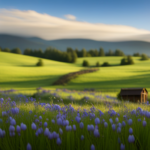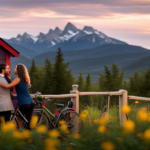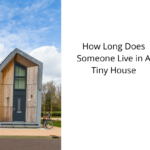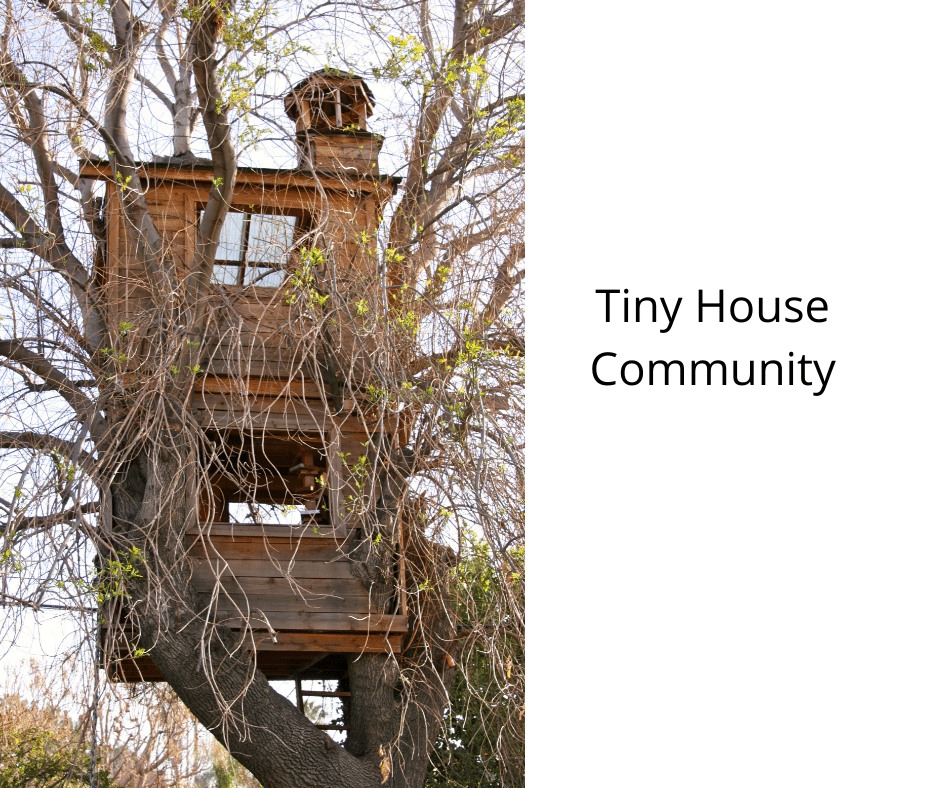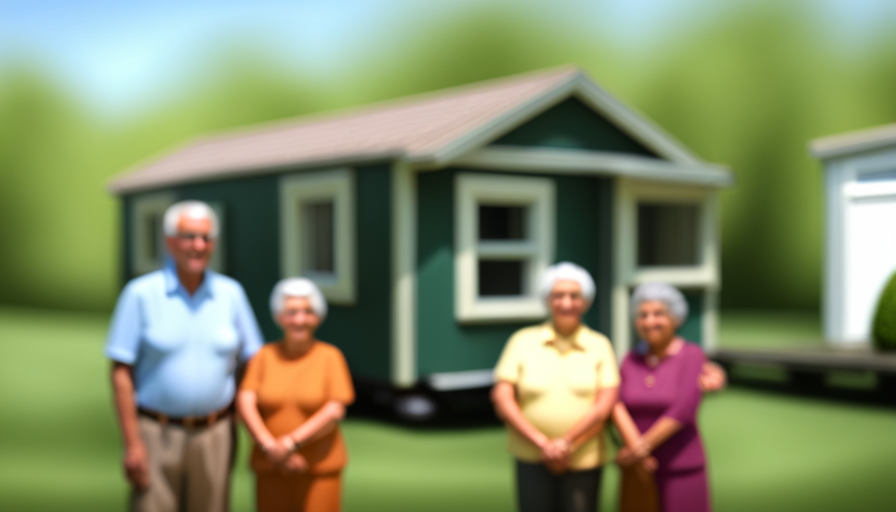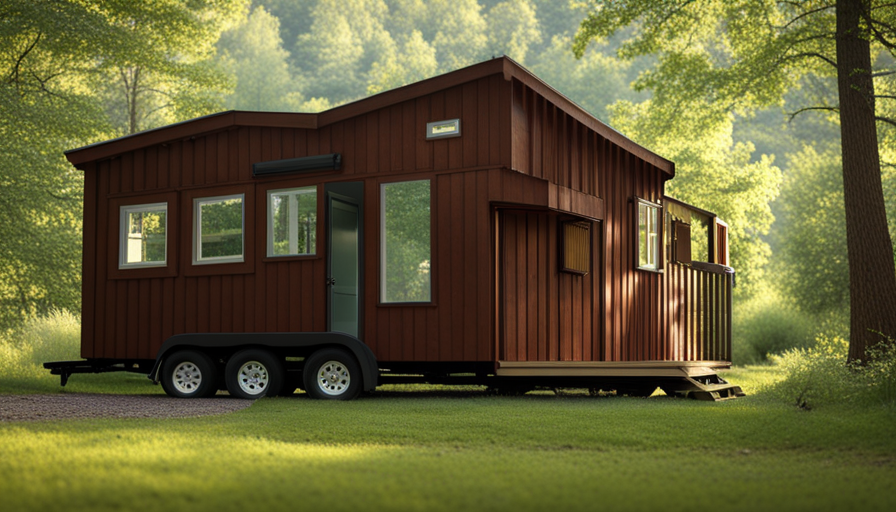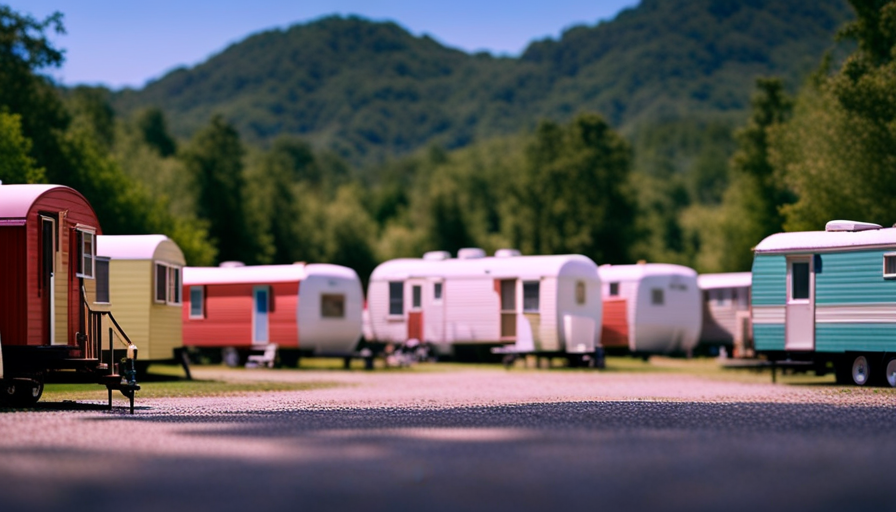Residing in a small home might appear to be an unrealistic aspiration to some, yet for numerous individuals, it has turned into an actual lifestyle.
Take the case of Sarah, a young woman who decided to downsize her life and move into a tiny house nestled in the countryside. At first, Sarah was apprehensive about the idea of living in such a small space, but she soon realized the countless benefits it brought. Not only did she drastically reduce her living expenses, but she also found herself surrounded by nature, peace, and simplicity.
However, tiny house living is not without its challenges. From designing and decorating a functional space to finding the perfect location, there are many factors to consider.
In this article, we will explore the ups and downs of living in a tiny house, share practical tips from experienced dwellers, and help you determine if this lifestyle is the right fit for you.
Key Takeaways
- Living in a tiny house offers financial freedom and reduces living expenses.
- Tiny house living promotes a minimalist lifestyle and environmental sustainability.
- Challenges of tiny house living include designing a functional space and dealing with zoning and legal restrictions.
- Building a strong sense of community is important in tiny house living.
Benefits of Downsizing to a Tiny Home
If you’re tired of drowning in clutter and yearn for a simpler, more manageable lifestyle, then downsizing to a tiny home is the answer you’ve been searching for.
Living in a tiny home allows you to embrace a minimalist lifestyle, where you prioritize experiences and relationships over material possessions. With limited space, you’re forced to declutter and keep only what’s truly necessary, leading to a sense of freedom and mental clarity.
Not only does downsizing to a tiny home promote a minimalist lifestyle, but it also promotes environmental sustainability. These small dwellings have a smaller carbon footprint, requiring less energy to heat and cool. Additionally, many tiny homes are built with eco-friendly materials and utilize renewable energy sources.
Transitioning to a tiny home lifestyle may have its challenges, but the benefits of living simply and sustainably far outweigh them.
Challenges of Tiny House Living
Living in a tiny house presents several challenges that require creative solutions. Limited space and storage solutions are a constant consideration, forcing me to prioritize what is truly essential.
Dealing with zoning and legal restrictions can be frustrating, as not all areas are welcoming to tiny homes.
Lastly, adapting to a different lifestyle and mindset is necessary, as living in a tiny house requires a minimalistic approach and a willingness to embrace simplicity.
Limited Space and Storage Solutions
When you’re in a tiny house, you’ll quickly realize that every nook and cranny is a treasure trove waiting to be discovered. Limited space can be a challenge, but with the right storage hacks, you can maximize every square inch of your home.
One of the first things I learned was to think vertically. By utilizing wall space with shelves, hooks, and hanging storage solutions, I was able to free up valuable floor space. I also invested in furniture that served multiple purposes, like a coffee table with hidden storage compartments or a bed with drawers underneath.
Being organized and decluttering regularly became essential in such a small space. It’s amazing how much you can fit when you’re intentional about what you keep.
Now, let’s talk about dealing with zoning and legal restrictions, which is another important aspect of tiny house living.
Dealing with Zoning and Legal Restrictions
Navigating zoning and legal restrictions can be a challenge, but understanding the rules and regulations is crucial in order to successfully build and enjoy your small dwelling. Dealing with building permits and navigating local regulations is a necessary step when it comes to living in a tiny house.
Each jurisdiction has its own specific requirements and limitations, so it’s important to do thorough research and consult with professionals who have experience in this area. Some areas may have restrictions on the size, height, and location of tiny houses, while others may require certain permits or inspections.
By familiarizing yourself with the local regulations, you can ensure that you are in compliance and avoid any potential issues down the road. Transitioning to a different lifestyle and mindset is the next crucial aspect of living in a tiny house.
Adapting to a Different Lifestyle and Mindset
Adjusting to a new way of life in a small dwelling requires a shift in your mindset and embracing a simpler, more intentional lifestyle. Adapting to the challenges of living in a tiny house can be both exciting and daunting.
One of the biggest adjustments is letting go of the idea that more is better. In a tiny house, you have to prioritize your belongings and only keep what’s necessary and truly brings you joy. This mindset shift can lead to a sense of freedom and liberation from material possessions. It also requires being mindful of your consumption habits and finding alternative solutions for everyday tasks.
Living in a tiny house encourages creativity and resourcefulness as you find innovative ways to maximize space and simplify your life. By embracing a different lifestyle and mindset, you can truly thrive in a small dwelling and enjoy the many benefits it brings.
As you settle into your new way of life, the next step is to start designing and decorating your tiny home, creating a space that reflects your personality and meets your needs.
Designing and Decorating Your Tiny Home
Designing and decorating your tiny home allows you to create a space that reflects your unique personality and style. Here are three designing tips and tiny home decor ideas to help you make the most of your small space:
-
Maximize storage: Utilize every nook and cranny by incorporating built-in shelves, hidden storage compartments, and multi-functional furniture. Opt for furniture with built-in storage, such as ottomans with hidden compartments or beds with drawers underneath.
-
Use light colors: Light, neutral colors can make your tiny home feel more spacious and open. Consider painting the walls in soft hues like white or light gray, and use light-colored furniture and accessories to create an airy and inviting atmosphere.
-
Embrace minimalism: In a tiny home, less is definitely more. Keep your decor simple and clutter-free to avoid overwhelming the space. Choose a few statement pieces that bring you joy and let them take center stage.
By designing and decorating your tiny home with these tips in mind, you can create a beautiful and functional space that suits your lifestyle.
In the next section, we will explore practical tips for tiny house living.
Practical Tips for Tiny House Living
When it comes to tiny house living, there are three key points that I find crucial to maintaining a comfortable and efficient lifestyle.
The first is organizing and decluttering your space regularly, as it’s essential to make the most of the limited square footage.
Secondly, managing utilities and resources efficiently is paramount to ensure that you’re using them wisely and minimizing waste.
Lastly, building a strong sense of community and support network is vital, as it can provide a sense of belonging and assistance when needed.
Organizing and Decluttering Your Space Regularly
Keeping your tiny house clutter-free and well-organized is key to maximizing your space and creating a cozy, stress-free environment. As someone who embraces a minimalist lifestyle, I’ve learned that regular organizing and decluttering is essential for maintaining a tiny house. To help you get started, here’s a simple method I use: divide your belongings into two categories, essentials and non-essentials. Create a 2 column and 3 row table to visualize this process.
| Essentials | Non-Essentials |
|---|---|
| Bed | Extra clothes |
| Kitchenware | Decorations |
| Toiletries | Books |
By focusing on essentials, you can prioritize what truly matters in your daily life. Regularly reassessing your belongings and letting go of non-essentials will open up more space and prevent unnecessary clutter. In the next section, I’ll share tips on managing utilities and resources efficiently.
Managing Utilities and Resources Efficiently
To maximize your space and create a cozy, stress-free environment, efficiently managing utilities and resources is crucial in your tiny home. Here are some tips for managing utilities efficiently and conserving resources effectively:
-
Install energy-efficient appliances to reduce electricity usage.
-
Use natural light as much as possible to minimize the need for artificial lighting.
-
Collect rainwater for non-potable purposes like watering plants or flushing toilets.
-
Implement a composting system to reduce waste and create nutrient-rich soil for your garden.
By managing utilities efficiently and conserving resources effectively, you can not only save money but also reduce your environmental impact. These practices are essential in a tiny home where every square inch matters.
In the next section, we’ll discuss how building a strong sense of community and support network can enhance your country living experience.
Building a Strong Sense of Community and Support Network
Developing a strong sense of community and building a support network is crucial for fostering a fulfilling and enjoyable lifestyle in your compact home. Living in a tiny house can sometimes feel isolating, but by actively building a sustainable community, you can create a sense of belonging.
One way to do this is by participating in local events and joining community organizations. This allows you to connect with like-minded individuals who share similar values and interests. Additionally, organizing regular gatherings or potluck dinners with your neighbors can help strengthen relationships and create a supportive network.
Building a strong sense of community not only enhances your daily life in a tiny house, but it also provides a safety net and support system when needed. By actively engaging with your community, you can find the right location for your tiny home that aligns with your values and needs.
Finding the Right Location for Your Tiny Home
Looking for the perfect spot to park your tiny home? Let’s explore how to find the right location for you.
-
Finding affordable land: Start by researching areas where land prices are more reasonable. Look for regions with lower population density and less demand for real estate. Consider purchasing a plot of land in a rural area or on the outskirts of a small town.
-
Pros and cons of rural vs. urban locations: Rural locations offer peace, tranquility, and lower costs, but they may lack amenities and have limited job opportunities. Urban areas provide convenience, access to services, and a vibrant community, but they can be more expensive and crowded.
-
Local regulations and zoning laws: Check local regulations and zoning laws to ensure that living in a tiny home is allowed in your chosen location. Some areas have restrictions on the size and placement of tiny homes.
-
Accessibility and resources: Consider access to basic necessities like water, electricity, and waste disposal. Also, evaluate the availability of healthcare facilities, grocery stores, and other essential services nearby.
Transitioning into stories and experiences from tiny home dwellers, it’s important to find the right location that suits your needs and preferences.
Stories and Experiences from Tiny Home Dwellers
Delightful tales and experiences from petite abode adventurers.
Living in a tiny house has brought me financial advantages and a positive environmental impact. Not only does it require fewer materials and resources to build, but it also consumes less energy for heating, cooling, and powering. This translates into lower utility bills and a smaller carbon footprint.
Let me share some stories from fellow tiny home dwellers. One couple I know sold their large suburban home and downsized to a tiny house. They were able to pay off their mortgage and now have more financial freedom to pursue their passions. Another friend decided to build a tiny house on wheels, allowing her to travel and explore different locations while still having a cozy home to return to.
Tiny house living offers unique experiences and opportunities. It’s about simplifying your life, reducing your environmental impact, and finding financial freedom. So, is tiny house living right for you? Let’s find out in the next section.
Is Tiny House Living Right for You?
Imagine a life where you can embrace simplicity, minimize your environmental impact, and experience financial freedom – could tiny house living be the perfect fit for you?
Living in a tiny house has its pros and cons, and it’s essential to consider them before making the leap.
On the positive side, tiny house living allows you to declutter your life and focus on what truly matters. It can be a great opportunity to downsize and reduce your carbon footprint. Additionally, the financial benefits of living in a tiny house are undeniable. With lower utility bills, mortgage payments, and maintenance costs, you can enjoy a greater sense of financial freedom.
However, it’s crucial to acknowledge the sacrifices that come with tiny house living. Limited space, lack of privacy, and the need for creative storage solutions can be challenging.
Ultimately, whether tiny house living is worth the sacrifice depends on your personal preferences and priorities.
Frequently Asked Questions
How much does it cost to build a tiny house?
When it comes to building a tiny house, the cost considerations depend on various factors. If you’re skilled and have the time, DIY can save you money. However, hiring professionals ensures expertise and saves you from potential mistakes.
Materials, size, and location also impact the cost. On average, building a tiny house can range from $20,000 to $100,000. It’s essential to carefully plan your budget and research costs before starting your tiny house journey.
Can I legally live in a tiny house anywhere in the country?
Yes, you can legally live in a tiny house anywhere in the country, but there are some important factors to consider.
Tiny house zoning varies by location, so it’s essential to research local regulations before moving forward.
Additionally, joining tiny house communities can provide support and resources for legal living arrangements.
By understanding the zoning laws and connecting with like-minded individuals, you can navigate the legalities and enjoy the benefits of tiny house living.
How do I handle issues with plumbing and waste management in a tiny house?
When it comes to plumbing maintenance in a tiny house, it’s important to stay on top of things. Regularly checking for leaks and blockages can prevent major issues down the line.
Utilizing eco-friendly waste disposal methods, such as composting toilets or greywater systems, can help minimize environmental impact. Remember to research local regulations and obtain necessary permits for waste disposal.
By being proactive and implementing sustainable practices, you can effectively manage plumbing and waste in your tiny house.
What are some common misconceptions about living in a tiny house?
Living in a tiny house comes with its own set of challenges and misconceptions.
One common misconception is that it’s easy and stress-free. While there are certainly pros, like reduced expenses and a simpler lifestyle, there are also cons to consider.
Common challenges include limited space, lack of privacy, and the need for creative storage solutions.
It’s important to weigh the pros and cons before deciding if this lifestyle is right for you.
Are there any restrictions or regulations I should be aware of when parking my tiny house on someone else’s property?
Are there any restrictions or regulations you should be aware of when parking your tiny house on someone else’s property?
Well, when it comes to tiny house parking, it’s important to consider local zoning laws and building codes. Some areas may require you to obtain permits or meet specific size requirements.
Additionally, you should also have a written parking agreement with the property owner, outlining things like rent, utilities, and maintenance responsibilities.
It’s always best to do your research and ensure you’re in compliance with all regulations before parking your tiny house.
Conclusion
So, is tiny house living right for you? Ultimately, that decision is up to you. But remember, the benefits of downsizing to a tiny home are boundless.
The challenges may be daunting, but with careful planning and practical tips, they can be overcome. Designing and decorating your tiny home can be a creative and fulfilling experience.
Finding the right location for your tiny home is crucial for a fulfilling country living experience. So, if you’re ready to simplify your life and embrace a cozy, compact lifestyle, then tiny house living may just be the perfect fit for you.
Hi, I’m Emma. I’m the Editor in Chief of Tiny House 43, a blog all about tiny houses. While tree houses are often associated with childhood, they can be the perfect adult retreat. They offer a cozy space to relax and unwind, surrounded by nature. And since they’re typically built on stilts or raised platforms, they offer stunning views that traditional homes simply can’t match. If you’re looking for a unique and romantic getaway, a tree house tiny house might just be the perfect option.


